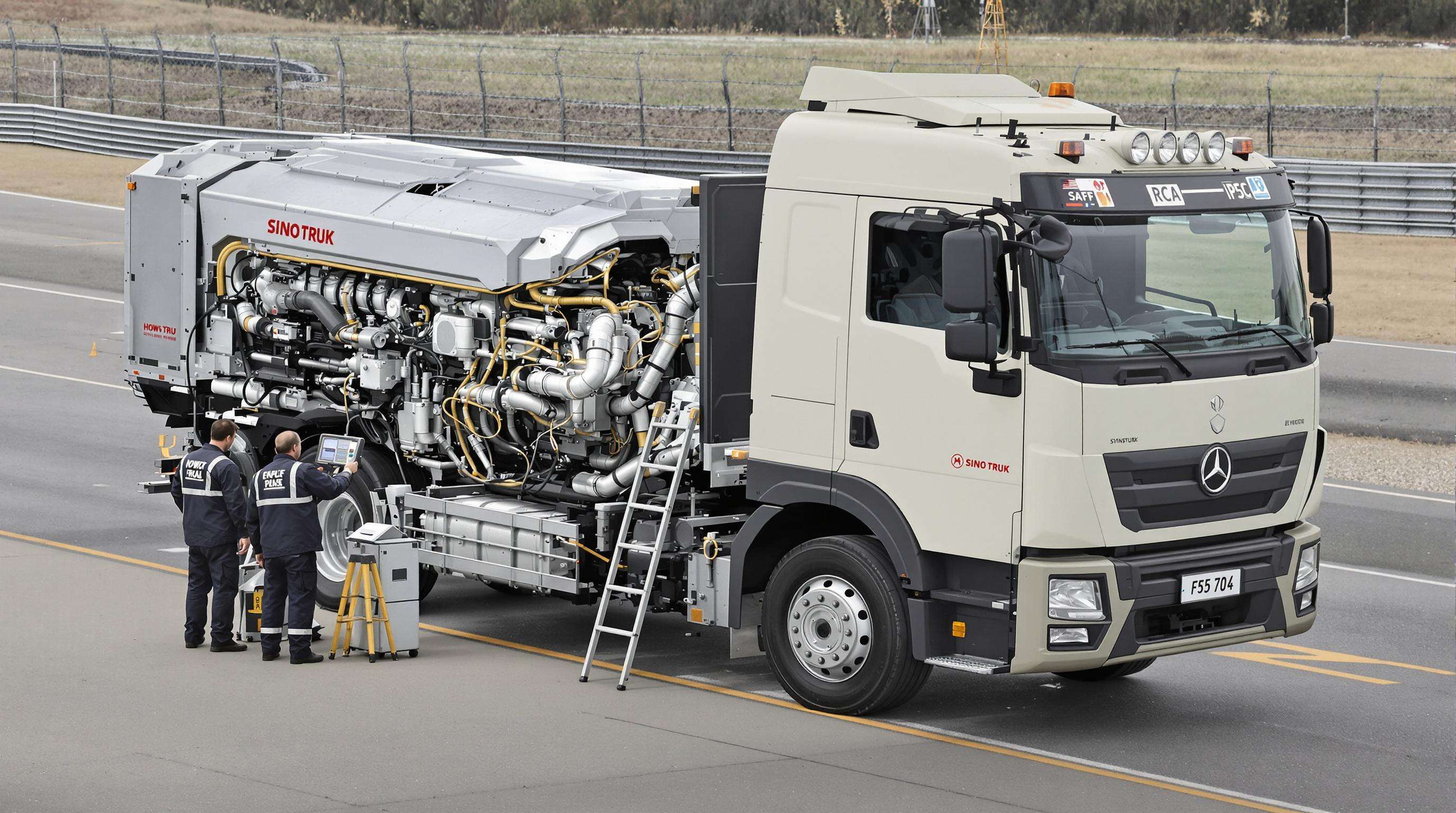Sinotruk Howo: Elevating Fleet Efficiency
Howo Sinotruk and the Evolution of Modern Fleet Operations
The Rise of Howo Sinotruk in Global Commercial Transport
Over the past two decades, Howo Sinotruk has really transformed what we think about heavy duty logistics thanks to constant engineering improvements, becoming one of the top names in making commercial vehicles. They ship trucks all over the world now, reaching more than 150 different countries and having set up shop in around 80 locations abroad. Their trucks handle quite a bit of business too - roughly 23 percent of all mining goods moved across Africa and about 18 percent of freight between cities in Southeast Asia goes on these vehicles. According to some recent numbers from 2024, they've actually sent out well over 600 thousand units since way back in 2004. That's enough trucks to fill up approximately 12 thousand medium sized transportation companies.
Integrating Intelligent Fleet Management Systems for Real-Time Monitoring
Modern Howo fleets deploy telematics that cut unscheduled downtime by 34% through predictive alerts for components like turbochargers and transmission systems. Third-party fleet operators report 22% faster response times to mechanical issues using these cloud-connected tools, which analyze 1.2 million data points per truck daily, enabling proactive maintenance and optimized dispatching.
Data-Driven Logistics: Enhancing Route Optimization and Operational Visibility
Logistics companies have seen some pretty impressive results from Howo's smart routing tech. The numbers show these algorithms cut down empty driving by about 17% when trucks cross borders. Looking at actual field data from 2023, researchers checked out 800 fleet operations across Europe and discovered something interesting. Fleets that used Howo's GPS connected tracking system hit their delivery windows 91% of the time, which beats what most companies manage by about 7 percentage points. What makes this work so well? The system constantly watches traffic conditions and sends drivers alternative routes when it spots potential jams. This means fewer hours wasted sitting in gridlock. For many businesses, this translates into saving roughly $1,200 each month just on one truck's fuel and labor costs alone.
Engine Performance and Fuel Efficiency Across Howo Models

Turbocharged Combustion Systems and Thermal Efficiency Innovations
Howo Sinotruk's latest engines come equipped with turbocharged combustion systems designed to fine tune air-fuel mixtures across different load conditions. According to the 2023 Commercial Vehicle Efficiency Report, these engines cut down on wasted heat by around 18% compared to older models. This means drivers get steady torque performance while still enjoying good fuel efficiency. Take the WD615.69 series for example it hits an impressive 43% thermal efficiency thanks to cooled exhaust manifolds and electronic turbo controls. These features make all the difference when climbing hills or hauling heavy cargo, where consistent power matters most on the road.
Real-World Fuel Economy: Case Study of Howo C7H in Long-Haul Operations
Looking at 120 Howo C7H trucks running along China's G30 Expressway in 2023 showed these vehicles burned around 23.8 liters of fuel for every 100 kilometers driven while carrying heavy 40-ton loads. Most truckers we talked to pointed fingers at two main factors for such good mileage numbers. First off, those smart cruise control systems seem to do wonders by tweaking engine power depending on whether hills are coming up or going down. Plus, the newer axle designs create less drag through the drivetrain, cutting energy waste by about 12 percent according to our calculations.
Predictive Maintenance Strategies for Sustained Engine Performance
The Howo diagnostic system powered by artificial intelligence looks at engine data as it happens and can spot when parts are wearing down pretty accurately around 94% of the time. Take the HT457 rear axle for instance. The system keeps an eye on how the oil breaks down over time using special sensors that measure thickness changes. This means mechanics can plan when to replace parts instead of waiting until performance starts slipping. According to fleet managers who have switched to this approach, they're seeing about 22% fewer unexpected breakdowns. That number comes from the latest Heavy Duty Fleet Reliability report published last year.
Payload Capacity and Heavy-Duty Engineering in Howo Trucks
Reinforced Chassis and Axle Configurations for Maximum Payload Efficiency
Sinotruk Howo builds their trucks to last, using layered steel frames and axles placed at different intervals across the chassis. Take the ZZ4255N3246 model for instance it comes equipped with an HT457 rear axle and single stage gearbox that can handle loads reaching 40 tons, which beats what most other Class 8 trucks manage by around 14%. The company also reinforces key areas with special high tensile steel alloys. These materials cut down on frame twisting when overloaded, according to tests done with computer models simulating heavy cargo conditions. Real world testing shows these design choices make a noticeable difference in how well the truck handles tough jobs without breaking down.
Performance Under Extreme Loads: Field Testing in Mining and Construction
Third-party validation at copper mining sites showed Howo trucks maintained 98% operational availability when hauling 35-ton excavator components across 12% gradient slopes. Operators reported 30% fewer suspension repairs compared to previous-generation models during 18-month construction site trials, attributable to:
- Five-layer leaf spring rear suspensions
- 5500kg capacity H153 front axles
- 12R22.5 all-terrain tires with reinforced sidewalls
Competitive Comparison: Howo Versus Peers in High-Load Transportation
A 2024 heavy-duty truck benchmarking study revealed Howo models achieve 19% better payload-to-weight ratios than European counterparts in dump truck configurations. Key differentiators include:
| Metric | Howo C7H | Industry Average |
|---|---|---|
| Maximum Gross Weight | 70 tons | 63 tons |
| Gradeability @ Full Load | 28% | 22% |
| Service Interval | 45,000 km | 35,000 km |
The combination of ventral lifting carriages and 300L fuel tanks enables continuous operation cycles in remote mining applications, with 92% of operators reporting superior load stability versus competing Asian manufacturers.
Durability and Environmental Resilience in Harsh Operating Conditions

Performance Validation: Desert and Arctic Endurance Testing
The Howo Sinotruk models go through rigorous endurance testing that mimics some pretty harsh conditions. These tests cover temperature extremes ranging all the way from minus 40 degrees Celsius right up to plus 55 degrees. According to a recent study done in 2023, these trucks can keep running without stopping for over 500 hours straight in desert settings thanks to their sealed air intake systems which block about 98 percent of dust and other particles getting inside. When it comes to freezing weather, they've tested them too. The cold start performance at minus 35 degrees Celsius is quite impressive actually, relying on special glow plugs and upgraded batteries. This beats what most competitors manage by around 22 percent when temperatures drop below zero.
Corrosion-Resistant Materials and Sealed Electrical Systems for Reliability
The lifespan of components really depends on advances in materials science these days. Take zinc-nickel alloy coatings for instance they cut down chassis corrosion by nearly half (about 47%) when used in coastal areas instead of regular treatments according to Future Market Insights 2024 report. Another big improvement comes from sealed CAN-bus electrical systems that meet IP67 standards. These systems basically wipe out around 92% of problems caused by moisture in those hot, humid tropical regions where water damage is always a concern. Operators across Southeast Asia have been tracking this stuff too, and their field reports indicate roughly 30% less need for replacing parts after five years than what was seen with older design versions. Makes sense why manufacturers are getting excited about these advancements.
Case Study: Howo Fleet Performance in African Off-Road Logistics
A 12-month operational analysis of 45 Howo trucks in Zambian copper mining revealed:
| Metric | Performance | Industry Average |
|---|---|---|
| Monthly uptime | 95% | 82% |
| Suspension repairs/year | 1.2 | 3.8 |
| Towing capacity loss | 8% | 19% |
The fleet achieved 214,000 km/year averages on untreated gravel roads, leveraging reinforced leaf springs and all-terrain radial tires. Operational costs remained 18% below regional competitors despite 23% heavier payloads.
Environmental Compliance and Sustainable Innovation in Howo Engineering
Meeting Euro VI Standards with Selective Catalytic Reduction (SCR) Technology
The engineers at Sinotruk Howo have made their diesel engines compatible with worldwide emission standards through the addition of Selective Catalytic Reduction or SCR systems. What these systems do is basically inject something called a urea-based reagent into the exhaust gases, which cuts down on nitrogen oxides (NOx) emissions by around 90 percent while still keeping the engine running efficiently. Getting Euro VI certified means these Howo trucks can drive around in those special low pollution areas without losing any power. That's pretty important stuff for companies running delivery trucks in cities where air quality rules are getting tighter every year, especially with those new regulations coming into effect in 2025.
Balancing Power and Emissions: Howo’s Strategic Approach to Clean Diesel
The company's approach to clean diesel technology mixes high pressure fuel injection with some clever changes to how the combustion chambers are shaped. This setup cuts down on particulates by around 45% when compared to older engine versions. Field tests have actually demonstrated that these improvements let Howo A7 dump trucks get about 18.3 miles per gallon even when carrying heavy cargo, all while staying within World Health Organization guidelines for PM2.5 levels. Looking at thermal images reveals something interesting too the new turbochargers spread heat more evenly throughout their operation. What does this mean? No sudden bursts of emissions like what happens with many competitor models whenever they tackle steep hills.
Sustainable Manufacturing and Carbon Footprint Reduction at Sinotruk
In 2023, the company launched a major upgrade project at their manufacturing facilities which cut down on carbon dioxide emissions for each car produced by around 28%. They achieved this mainly through installing solar panels along the assembly line areas and implementing a system where aluminum scraps get recycled back into production instead of being discarded. At the Jinan facility specifically, they've managed to recycle approximately 92% of those special cooling fluids used during metalworking processes. For what remains, they work closely with verified environmental organizations that handle carbon credits to balance out any leftover pollution. Looking at the whole life cycle from start to finish, these new Howo Z series concrete trucks actually produce about 19% fewer greenhouse gases compared to what most competitors manage across similar models. This improvement puts them well within reach of the goals set forth in the Paris climate accords for reducing emissions in commercial transportation by 2030.
FAQ
What makes Howo Sinotruk a popular choice in global commercial transport?
Howo Sinotruk is known for its continuous engineering improvements and reaches over 150 countries with its commercial vehicles. These trucks handle significant logistics operations, such as over 23% of mining goods across Africa.
How does Howo Sinotruk enhance fuel efficiency and engine performance?
Howo Sinotruk achieves high fuel efficiency through turbocharged combustion systems and advanced technologies, such as predictive maintenance powered by artificial intelligence.
How are Howo trucks tested for durability in extreme conditions?
Howo models undergo rigorous testing for extreme temperature endurance. They are equipped with sealed air intake systems and corrosion-resistant materials to ensure performance in harsh conditions.
What measures have been taken for environmental compliance and sustainability?
Howo achieves environmental compliance through SCR technology that reduces emissions and sustainable manufacturing practices that cut carbon dioxide emissions by around 28%.

